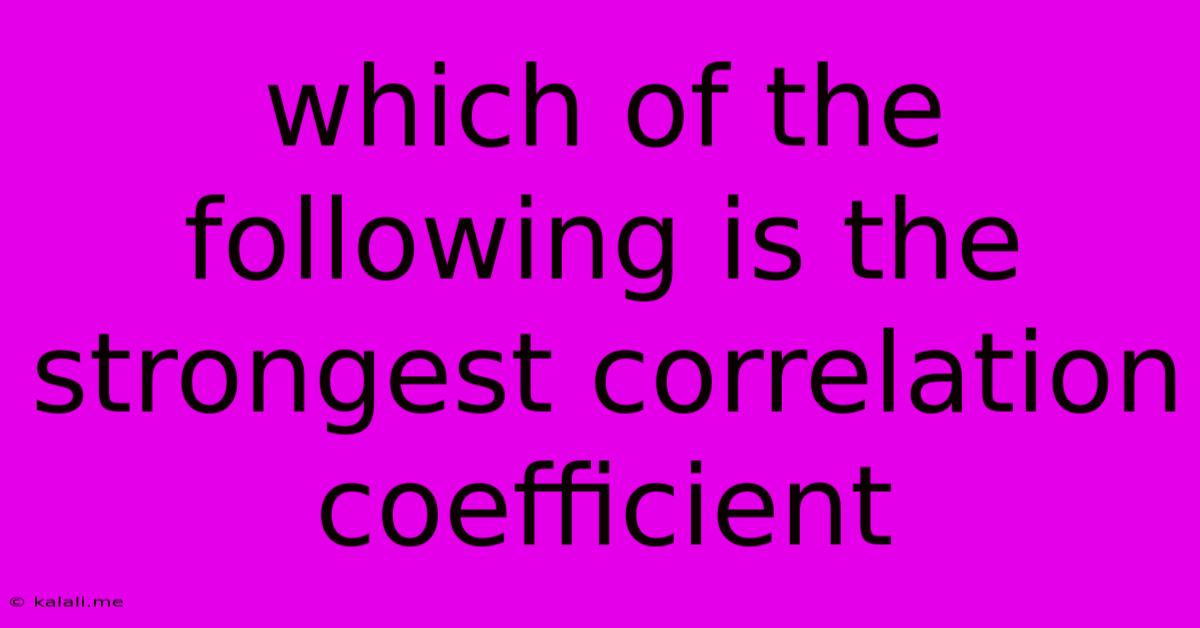Which Of The Following Is The Strongest Correlation Coefficient
Kalali
Jun 11, 2025 · 2 min read

Table of Contents
Which of the Following is the Strongest Correlation Coefficient? Understanding Correlation Strength
Correlation coefficients are vital statistics used to measure the strength and direction of a linear relationship between two variables. Understanding which coefficient represents the strongest relationship is crucial for interpreting data and drawing meaningful conclusions. This article explores how to identify the strongest correlation coefficient from a given set of values. We'll also delve into the concept of correlation strength and its implications.
What is a Correlation Coefficient?
A correlation coefficient is a numerical value ranging from -1 to +1 that quantifies the association between two variables. The sign (+ or -) indicates the direction of the relationship:
- Positive correlation (+): As one variable increases, the other tends to increase.
- Negative correlation (-): As one variable increases, the other tends to decrease.
The absolute value of the coefficient signifies the strength of the relationship:
- Strong correlation: Closer to 1 (either positive or negative).
- Weak correlation: Closer to 0.
Identifying the Strongest Correlation Coefficient
When comparing several correlation coefficients, the one with the highest absolute value represents the strongest correlation. Ignore the sign; focus solely on the magnitude. For example:
- +0.85 indicates a stronger correlation than +0.60.
- -0.90 indicates a stronger correlation than +0.75 or -0.70.
- A correlation coefficient of 0 indicates no linear correlation.
Examples:
Let's consider these correlation coefficients:
- r = +0.70
- r = -0.82
- r = +0.35
- r = -0.95
In this case, r = -0.95 represents the strongest correlation because its absolute value (0.95) is the highest. The negative sign only indicates an inverse relationship, not a weaker one.
Interpreting Correlation Strength
While the absolute value determines strength, it’s important to interpret the magnitude in context:
- Strong (|r| ≥ 0.8): Indicates a strong linear relationship. Changes in one variable are strongly associated with changes in the other.
- Moderate (0.5 ≤ |r| < 0.8): Shows a notable but not overwhelming linear relationship.
- Weak (|r| < 0.5): Suggests a weak linear relationship or possibly no relationship at all. Other factors might be at play.
It's crucial to remember that correlation doesn't imply causation. Even a strong correlation doesn't prove that one variable causes changes in the other. There could be other underlying factors or confounding variables influencing the relationship.
Further Considerations:
- Sample Size: The reliability of a correlation coefficient is affected by the sample size. Larger samples generally lead to more reliable results.
- Outliers: Extreme values (outliers) can significantly influence correlation coefficients. Careful data analysis is crucial to identify and address outliers.
- Nonlinear Relationships: Correlation coefficients only measure linear relationships. A strong nonlinear relationship might not be captured accurately by a correlation coefficient.
By understanding the interpretation of correlation coefficients and focusing on the absolute value, you can accurately determine the strength of the relationship between two variables. Remember to consider the context, sample size, and potential limitations when interpreting these crucial statistical measures.
Latest Posts
Latest Posts
-
Which Cell Organelle Is Found Only In Plant Cell
Jun 13, 2025
-
How Many Molecules Of Water In A Drop
Jun 13, 2025
-
Which Of The Following Is True About
Jun 13, 2025
-
How To Subtract Rows In Excel
Jun 13, 2025
-
Acceptance Rate For University Of Hawaii
Jun 13, 2025
Related Post
Thank you for visiting our website which covers about Which Of The Following Is The Strongest Correlation Coefficient . We hope the information provided has been useful to you. Feel free to contact us if you have any questions or need further assistance. See you next time and don't miss to bookmark.